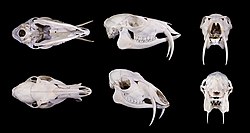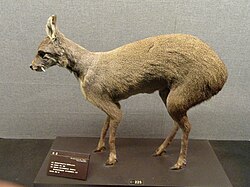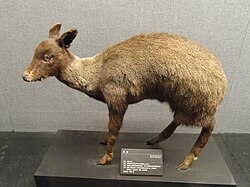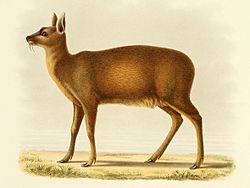Musk deer
Musk deer are a group of even-toed ungulate mammals. They form the family Moschidae. There is only one genus in Moschidae, Moschus.[1] There are five species of musk deer, and they are all very similar.
| Musk deer | |
|---|---|

| |
| Moschus moschiferus | |
| Scientific classification | |
| Kingdom: | |
| Phylum: | |
| Class: | |
| Order: | |
| Family: | Moschidae (Gray, 1821)
|
| Genus: | Moschus (Linnaeus, 1758)
|
Musk deer are not true deer, and are classed in a different family. Unlike other deer, musk deer do not grow antlers. Instead, they have large canine teeth that reach down from the mouth. The Musk deer emits a particular odor which gives it its name.
Taxonomy
- Family Moschidae[2]
- Himalayan musk deer (Moschus leucogaster)
- Alpine musk deer (Moschus chrysogaster)
- Siberian musk deer (Moschus moschiferus)
- Black musk deer (Moschus fuscus)
- Dwarf musk deer (Moschus berezovskii)
- Kashmir musk deer (Moschus cupreus)
Appearance
Musk deer are about 90 centimeters long and about 60 centimeters high with a tail length of 4-6 centimeters. They weigh about 10 kilograms. Musk deer usually have dark brown fur. Males have long upper canine teeth (called tusks), which can be up to 7 cm long. Musk deer do not have antlers. Male musk deer also have a musk gland.
Habitat
Musk deer live in the mountain forests of Asia, Russia, China, and the Korean Peninsula. They live in the mountains, mostly at heights of 2500 to 3500 meters.[3] They live in dense forests.
Life
Musk deer are mostly active at night. Musk deer eat grass and moss; in winter they also eat twigs and lichen.
Musk deer live alone. They only come together to mate. If two male musk deer meet, they fight, during which they can seriously hurt each other with their tusk-like teeth.
The female gives birth to 1-2 babies. A musk deer baby has spots on its fur.
Musk deer and humans
Male musk deer have a gland that produces musk. Musk is used to make perfumes and soap, and it is also used in Traditional Chinese medicine. One musk gland has about 25 to 30 grams of musk. Musk deer have been hunted and killed for its musk. Because of this, musk deer have become fewer and endangered. Another method is to catch a living musk deer, take its musk, and let it go free again. This method takes more time, so it is not used often. There are also musk deer farms.[2]
Musk Deer Media
Skeleton of Micromeryx showing the general skeletal features
References
- ↑ "Moschidae". Animal Diversity Web. Retrieved July 20, 2021.
- ↑ 2.0 2.1 Paras Bikram Singh; Janak Raj Khatiwada; Pradip Saud; Zhigang Jiang (March 20, 2019). "mtDNA analysis confirms the endangered Kashmir musk deer extends its range to Nepal". Scientific Reports. Nature. 9 (1): 4895. Bibcode:2019NatSR...9.4895S. doi:10.1038/s41598-019-41167-4. PMC 6426878. PMID 30894581.
- ↑ Stephane Ostrowski; Haqiq Rahmani; Jan Mohammad Ali; Rita Ali; Peter Zahler (October 22, 2014). "Musk deer Moschus cupreus persist in the eastern forests of Afghanistan". Oryx. Cambridge University Press. 50 (2): 323–328. doi:10.1017/S0030605314000611. S2CID 86387555. Retrieved July 21, 2021.
| Wikispecies has information on: Moschidae. |
| Wikimedia Commons has media related to Lua error in Module:Commons_link at line 62: attempt to index field 'wikibase' (a nil value).. |





